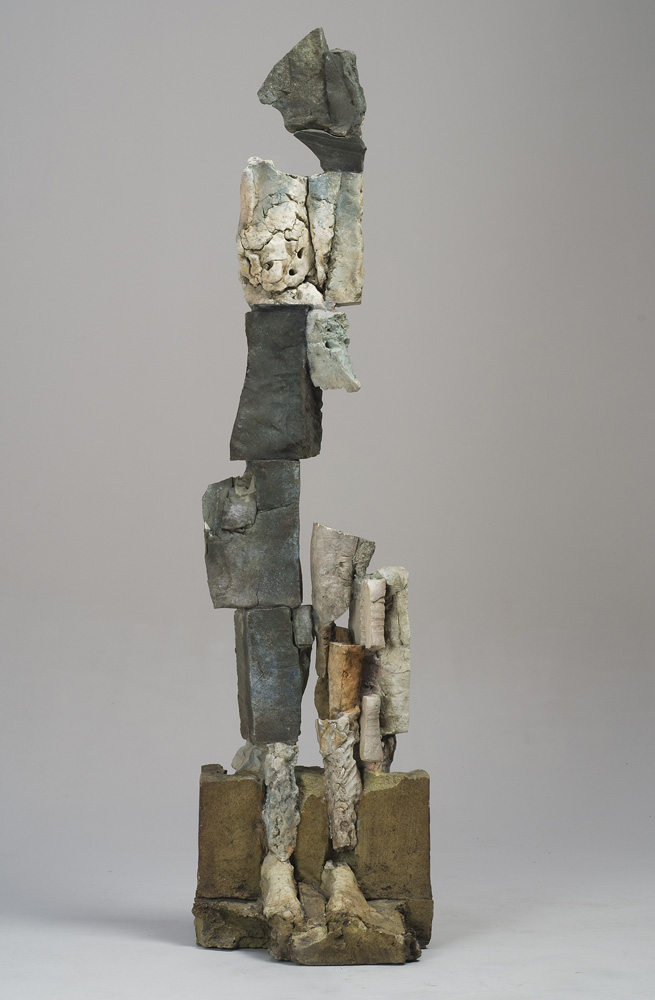by Peter Selz
For almost fifty years Stephen De Staebler has been engaged in building fractured human figures made of clay, which, he points out, is the crust of the earth (Latin for terra-cotta). He was introduced to clay at Berkeley in 1958 and studied with Pete Voulkos, the master of clay, and, like Pete, he built his own kiln and was on his way. He was mesmerized by the resistance of the material during the process of shaping it and by the unpredictability of the result when the work was fired. Like the Abstract Expressionist painters, de Staebler welcomed the element of chance.
He was born in St. Louis in 1933 and remembers playing basketball in high school, and basketball is a serious matter in Missouri. He speaks about the game as visual and spatial experience, of moving in space with disciplined rhythm--not entirely unlike working with clay. He then went on to Princeton, where he majored in religion and wrote his thesis on St. Francis of Assisi, who, he points out, is "much more interesting than a gentle monk who is feeding the birds." His study of St. Francis and his background in religious studies were important when he received a major commission early in his career to design and build the sanctuary and crucifix for the Newman Center in Berkeley. He succeeded in fusing the architecture and sculpture into total ensemble, creating one of the few successful ecclesiastical artworks in recent times. De Staebler, however, does not subscribe to any organized religion. His fractured figures in their incompleteness do not comply with any sort of dogma.
During the early 1970s, the sculptor made a series of horizontal slabs, which hugged the ground. Soon, however, the partial vertical figure became dominant in his work. The fragmented human figure has been almost endemic to modernist sculpture ever since Auguste Rodin presented his The Walking Man in 1905. The human torso was a dominant theme in the works of sculptors as diverse as Maillol and Brancusi, Henry Moore and Alberto Giacometti. In recent years the poignant headless figures by Magdalena Abakanowicz and the clay and bronze figures by de Staebler assume a symbolic function of human incompleteness and concomitant yearning for wholeness. In the 1980s, de Staebler produced a large series of sculptures in which charred legs were metaphors for the human body, which, in turn encompasses the spirit.
During the last few years the artist has continued to produce sculptures that resemble totems of an ancient culture, defiant witnesses of endurance. Like his earlier pieces, they have no gender, but are endowed with a sense of the universal human condition. These sculptures are assembled from previously fired fragments, many of them buried in what he calls his "bone yard." Working like an archaeologist he excavated these pieces and assembled them into new iconic figures. They are not painted or patinated. Their earthy colors are derived from pigments and oxides, which he applied before firing. A large sculpture like Figure with Lost Torso (2008)--as seen at the artists recent solo exhibition at the Dolby Chadwick Gallery in San Francisco, which ran from January 14 – February 27, 2010--is compiled of different kinds of clay, which the artist fired over a long period of time.
De Staebler has absorbed the art of Egyptian and archaic Greek effigies and moderns such as Rodin and Giacometti. Relating his innovative work to the evolving history of sculpture, he has created work of profound authenticity.
Stephen De Staebler | Figure with Lost Torso, 2008 | Fired clay | 76 x 18.5 x 21 inches

